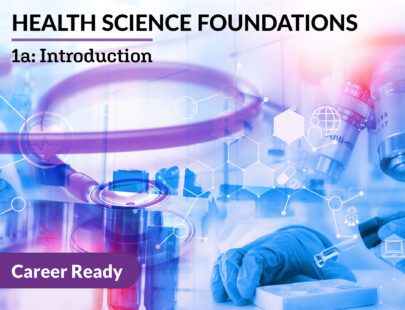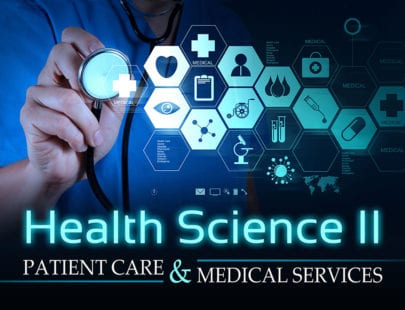
Health Science: Nursing
The demand for nurses has never been higher! Learn what it takes to become a nurse, pursue a career, and understand the practice of nursing and the healthcare system. With a strong focus on patient care, you’ll explore safety, communication and ethics, relationship building, and how to develop wellness strategies for your patients. From emergency to rehabilitative care, to advances and challenges in the healthcare industry, discover how you can launch a fulfilling career providing care to others.
Units at a Glance
Unit 1: Opportunities in Nursing
Nursing is a meaningful and satisfying career choice, and the demand for nurses has never been higher! But how do you become a nurse? To begin, you may want to learn about training to become a nurse, different nursing jobs, and the basics of what a nurse can do. So many opportunities are available in the diverse and constantly evolving field of nursing, so let’s start exploring what it takes to enter this popular and essential profession!
What will you learn in this unit?
- Explain the difference between a CNA, an RN, and a LPN
- Discuss how technology is changing the healthcare field
- List more than twenty nursing specialties
- Find appropriate nursing schools for your goals
- Demonstrate professional hygiene, punctuality, and conduct
Unit 2: The Healthcare System
Insurance, co-payments, public, private—it’s so confusing! How does the healthcare system work? Just like the many parts of the body work together, our modern health system is made up of many parts that work together to deliver healthcare. Learn some of the history of healthcare, the different parts of our modern healthcare systems, and find out how this complex system delivers care to diverse people. Plus, discover the important role nurses play at every level of the system!
What will you learn in this unit?
- Describe the origins of today’s healthcare system
- Understand how public health improves population health
- Identify the services nurses provide
- Tell the difference between public and private hospitals
- Recognize the hierarchy of nursing staff in a hospital
Unit 3: The Human Body & Body Systems
The human body is nothing short of amazing. In this unit, you will be introduced to basic human anatomy and physiology. You’ll also become familiar with the complex structure of tissues, organs, cells, and the various systems within the body. While exploring how these things are organized, you will gain an understanding of how all of these parts interact and depend on each other.
What will you learn in this unit?
- Differentiate between anatomy and physiology
- List the characteristics of all living things
- Envision the inside of a living cell
- Divide the body into distinct regions
- Break down the factors that affect homeostasis
Unit 4: Ethical & Quality Care
Right and wrong. Black and white. It would be nice if all ethical decisions could be so clear. Since ethics in medicine involves weighing many factors, it’s a bit more complicated to figure out the right thing to do. Luckily, nursing has some guidelines that help you make good decisions. Plus, there are laws you need to know and follow to be a nurse. Using case studies containing difficult situations, you will get to decide what you might do if you were to find yourself in the same spot!
What will you learn in this unit?
- Decrease the number of preventable errors in a healthcare setting
- Describe the ethical principles involved in nursing
- Research the laws of nursing for your state
- Use nursing’s standard process for solving problems
- Recognize signs of domestic abuse and neglect
Unit 5: Building Relationships
Are you a good listener? Or do you like to talk? Either way, one nursing skill that will change how you communicate professionally is active listening. Communication is one of the most important skills in nursing–both with patients and colleagues on the healthcare team–and one of the most important life skills too! Effective and sensitive communication will allow your patients to trust you so that you can better care for them. So, read on, and learn interesting facts about communication, techniques to improve communication, the things that can hinder communication, and even what it takes to become a leader in healthcare.
What will you learn in this unit?
- Practice active listening
- Foster positive communication
- Work through conflicts
- Define Patient Centered Care
- Differentiate between personal and professional relationships
Unit 6: Wellness Strategies for a Healthy Lifestyle
What happens if we think about health rather than sickness? As a nurse, your job is to promote health, which does involve healing illness, but think on the positive side. Wellness and well-being are an optimistic way of thinking about a job in healthcare—a cup half-full rather than half-empty. Nurses have a pivotal role in gently helping improve patients’ wellness, and there are so many interesting ways to go about it (and even some really cool and weird ways). From preventive self-care to alternative energy medicine, thinking about the whole health of the person can be inspiring!
What will you learn in this unit?
- Identify a nurse’s role in promoting wellness
- Distinguish between ergonomics and body mechanics
- Name several types of complementary and alternative medicine
- Ask questions to assess nutritional wellness
- Recommend activities to manage and reduce stress
Unit 7: Nursing Process: A Day in the Life
From intake to discharge, nurses perform their duties with efficiency and grace. What, exactly, do nurses do all day? Now is your chance to take a glimpse into a day in the life of three different types of nurses. While we track their activities during a day, we will find out more about the procedures they follow and that important part of their job–documenting information. Data drives everything in medicine these days, and correct reporting and recording of all care is part of everyone’s day!
What will you learn in this unit?
- Choose the type of assessment appropriate for different situations
- Document assessments, interventions, and evaluations
- Identify different assessment models
- Explain the Hierarchy of Needs
- Differentiate between a medical diagnosis and a nursing diagnosis
- List the steps of the Nursing Process
Unit 8: Emergency Care
There’s nothing that gets the adrenaline pumping like an emergency. No wonder there are so many TV shows that take place in an ER. Emergency nursing is a great career for someone who is the go-to person in any emergency—calm, collected, quick-thinking, and confident. Even if you don’t see your future as being on the front lines of emergency response, every type of nurse needs to know the skills—CPR and basic first aid—to save a life. And while reacting with speed, ER nurses have an eagle eye on all the possible hazards in the hospital. Safety first—this is the motto for all nurses, but in the ER, it is doubly important!
What will you learn in this unit?
- React to a fire and save lives: RACE!
- Understand the laws of consent in an emergency
- Describe different methods for taking vital signs
- Identify safety hazards in a hospital setting
- Properly use the abbreviations: CPR, FBAO, AED, and DNR
Unit 9: Fighting Pathogens
The world is full of disease-causing agents, and it sometimes feels like it is us against them—humans versus all those bacteria and viruses. But wait! There are superheroes bravely (and successfully) fighting the spread of disease—nurses! Healthcare workers—and especially nurses—fight the threat of bloodborne diseases and other pathogens with skill and perseverance. The practices and techniques that nurses employ to break the chain of infection may seem simple, but they are important to follow at all times. In this unit, we will look at what pathogens are, how to prevent transmission, and how to be a caring nurse while staying healthy yourself!
What will you learn in this unit?
- Dispel the myths about bloodborne diseases
- Act to reduce risk if a needlestick or other contamination occurs
- Identify risky behaviors for the spread of bloodborne viruses
- Apply infection-control techniques
- Name the three types of transmission-based precautions
Unit 10: Rehabilitation
When someone has a serious disease, injury, or surgery, it takes time and lots of help to recover. Here is where rehabilitation nurses can work their magic! Not only do patients need help to get back to moving around themselves, but they and their families need help in adapting to normal life again. In this unit, we will practice the moves you need to know to help an injured person regain their mobility. Plus, we will gather some tools for handling the natural stress response of patients when they face illness. While learning about the rewarding job of rehabilitation nursing, where nurses often get to know their diverse patients well over a long period of time, we will gain skills to help people with short- or long-term disabilities.
What will you learn in this unit?
- Perform range-of-motion exercises
- Safely transfer a patient from bed to chair or walking
- Describe the body’s responses to stress
- Use evidence-based practice to make decisions
- Name anatomical terms for movement
Unit 11: Global Impact of Healthcare
Nurse superheroes fight off pathogens all around the world—saving lives and educating civilians with their knowledge, caring, and understanding of the principles of sanitation! Infectious diseases can spread around the world faster than ever, so every nurse needs to know what infections and diseases are on the rise. Since nurses make up the largest part of the international healthcare workforce, they are integral to the functioning of the global health system. Prevention of communicable disease through vaccination and sanitation saves millions of lives every year, but more needs to be done to reach every person: Nurses are on the forefront of the push to get care for all!
What will you learn in this unit?
- Apply interventions to break the chain of infection
- Describe the modes of transmission of diseases
- Define emerging infectious diseases and prevention techniques
- Explain nosocomial infection and precautions to reduce them
- Research and identify global health organizations that work with nurses
Unit 12: Trends and Challenges
How do you lower the cost of healthcare while increasing the number of people who can access care? Well, you expand the role of nurses in the global healthcare system! Nurses are being encouraged to take on new roles and more responsibilities in healthcare, and this trend is bringing even more emphasis to nursing to help meet the challenges of an aging global population, poverty, and a need to improve healthcare infrastructure. Nurses can keep costs down for basic healthcare, implement technological advances in electronic medical recordkeeping, and advocate for the eradication of healthcare inequity. This is a big job for nurses, and the shortage of nurses is predicted to continue. To tackle all of this, and to have a satisfying career, the world needs more people of all ethnicities and genders to enter the profession of nursing!
What will you learn in this unit?
- Describe the benefits of expanded nursing roles in healthcare
- Identify uses for smart phones in global healthcare
- List computer skills needed in nursing
- Discuss how socioeconomic status affects health
Required Materials
- Computer with word processing program like MS Word, Excel-type program, and slide show program like PowerPoint
- Computer with access to internet
- Brochure maker software (optional)
- Video Recording device: smart phone, digital camera with audio, computer camera, or any device that can record both video and sound.
- First aid kit and supplies:
- Alcohol and cotton swabs or alcohol wipes
- Syringe or object to mimic syringe (pencil)
- Bandage materials: sterile gauze, tape, large bandages
- Space blanket
- Antiseptic cream/gel
- Scissors
- Cold pack
- Surgical Gloves
- Surgical Gown (or clothing that is similar)
- Object like a piece of fruit to demonstrate asepsis
- Clean towels or pieces of cloth
- Thermometer
- Bathroom scale
- Yardstick or measuring tape
- Stopwatch or watch with timer or second hand
- Friend or family member to act as your “patient”
- Practice dummy: a large pillow or stuffed animal is a good substitute
- Automated External Defibrillator or a box with two strings attached; the strings will need adhesive bandages or tape on the ends



